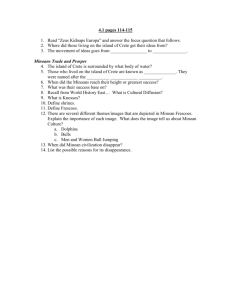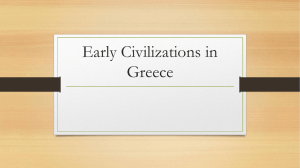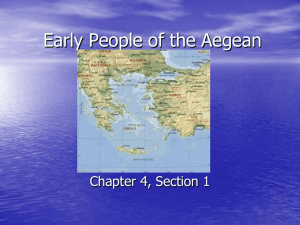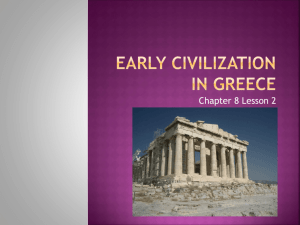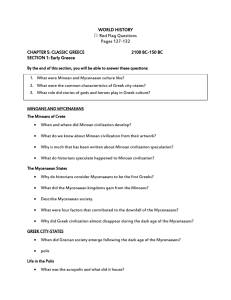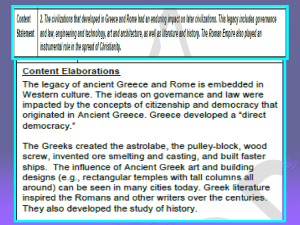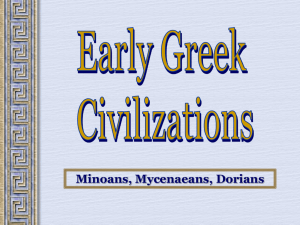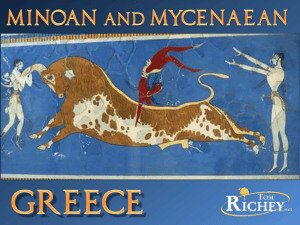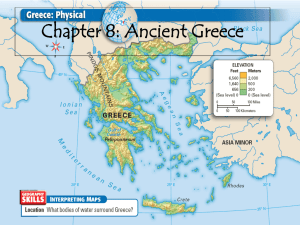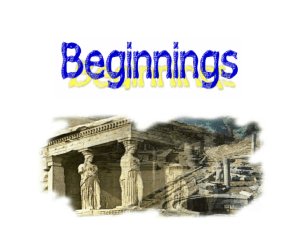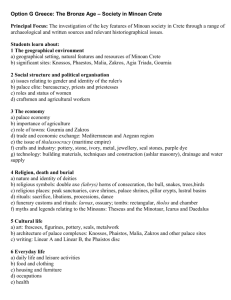Minoans and Mycenaeans of Ancient Greece
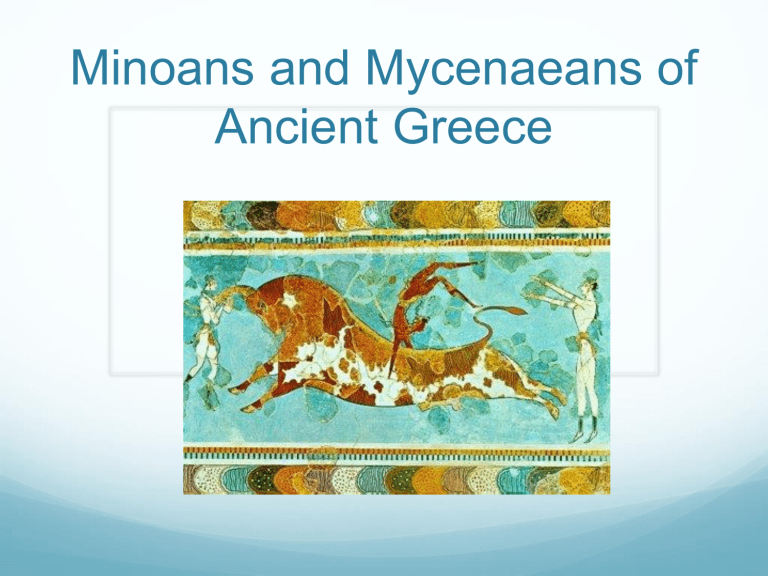
Minoans and Mycenaeans of
Ancient Greece
A Land Called Hellas
Peninsula and series of island in the Aegean Sea
Rocky, mountainous peninsula with little natural running water
Cyclades – Greek islands in the
Aegean
Crete – largest island in the
Aegean
Geographical fragmentation led to political fragmentation
Communication weak b/c of rough travel between settlements
First Peoples of Greece
Neolithic villages and farming sites on Crete and mainland – but did not establish contact with each until 2000 B.C.E.
Adoption of metallurgy increased prosperity – bronze tools and weapons
Central location of Crete allowed for trade and contact with other civilizations – development of Aegean economy
Center of Mediterranean trade
These factors led to the rise of Minoan culture on Crete
The Minoans
The name “Minoan” comes from the mythical King Minos (of
Minotaur fame…)
Understanding of Minoan culture is limited b/c their literature has not been deciphered – Linear A
Instead, we examine the art and archeology!
Minoan culture centered around the palace
– political and economic center of society
Ex: Palace at Knossos
Ruled by a king and his nobles
Farmers, shepherds, artisans, merchants
Slaves
The Minoan Frescoes
Most prevalent form of Minoan art
Depict a variety of scenes…
Women and men leading religious activities
Entertainment (i.e. bull jumping)
Sea life and natural world
People hunting, in court, daily activities
Crete was possibly more egalitarian than other ancient cultures
Here come the Mycenaeans!
Arrival of Greek speaking peoples around 2000 B.C.E.
Three main groups
– all considered themselves Greek
Aeolians – Thessaly and Boetia
Ionians – Attica and Euboea
Dorians – Argos and Laconia (Sparta)
Founded powerful kingdom at Mycenae – became the
Mycenaeans
Also founded kingdoms at Thebes, Athens, and other sites
Center of economic and political life was the king and palace
Extensive division of labor controlled by the palace
Written language known as
Linear B
Used to record economic activity
Recorded offerings to familiar deities – Zeus, Apollo, Athena
Linear B deciphered in 1950s
Study of Linear B tablets shows that Greeks brought their religion and deities with them when they migrated to
Greece
Mycenaeans vs. Minoans
Contact between the two groups initially peaceful
1450 B.C.E. Mycenaeans attacked Crete
Destroyed many palaces – including Knossos
Mycenaneans benefitted from the collapse of the Minoans
Access to more Mediterranean trade – more money!
Imported luxury goods
Mycenaean ceramics widely distributed across Mediterranean
Mycenaeans adopted many aspects of Minoan culture (ex:
Frescoes)
Frescoes suggest more militaristic society
– lots of warriors and hunters
Fall of the Mycenaeans and Dark
Age Greece
Between 1300 and 1000 B.C.E. Mycenaeans experienced attacks from outside invaders – Sea Peoples or Dorians?
Discord between kingdoms led to weak defense
Part of larger collapse of societies at end of Bronze Age
Fall of Mycenaeans ushered in Dark Age, 1100-800 B.C.E.
Society was localized, poor, illiterate
Widespread depopulation and migration
Greek people spread to outlying parts of Greece, Asia Minor, and
Cyclades
However, the Greek people and culture survived when other empires collapsed
Greek religious cults and small scale social organization
Ways of Interpreting Myth
As a belief system
As disguised history
As disguised philosophy or allegory
As fables illustrating moral truths
As allegories of natural events
As pre-scientific explanation
As charters for customs, institutions, or beliefs
As religious power, or metaphors for the unknown
As expressions of religious rituals
As examples of psychological archetypes
As stories
As embodying irreconcilable structural conflicts in social systems
